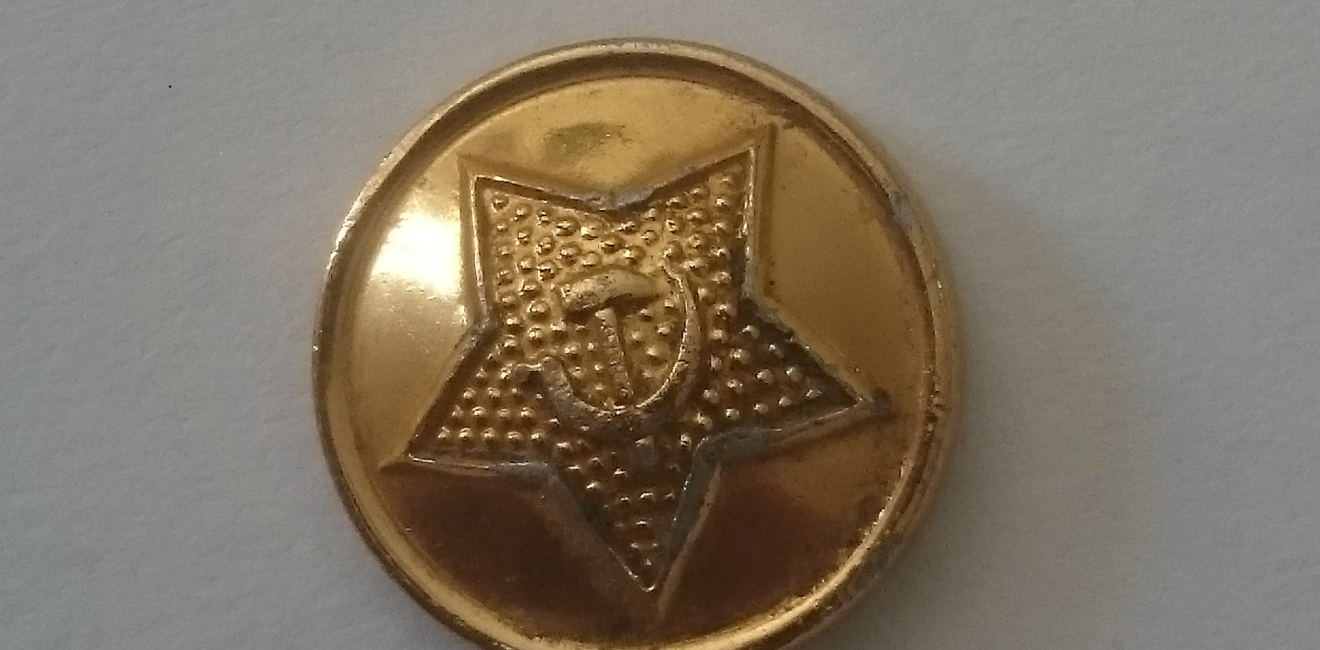Right on the Button
Did Soviet military advisers accompany the Egyptian Army into Sinai in mid-May 1967?

A blog of the History and Public Policy Program
Did Soviet military advisers accompany the Egyptian Army into Sinai in mid-May 1967?

Brass as Historical Evidence
One of the reasons we welcome opportunities to talk about our research (as we’ll be honored to do at the Washington History Seminar on October 16, 2017) is that doing so almost invariably elicits new evidence.
Often the evidence comes in the form of personal reminiscences, awoken from long hibernation, which then have to be verified and followed up on. Sometimes the informants suddenly recall that they have documents too, stashed away somewhere. And occasionally we hit the jackpot with a physical exhibit that all but clinches a case (the use of such detective-novel tropes in the context of historical investigation reflects our actual feelings in the act).
One such discovery came after we spoke at an Israeli journalists’ retreat about our attribution of the 1967 Six-Day War to deliberate Soviet instigation. A listener named Israel Arif-Katz came forward. “You know, I have a tiny brass button with Soviet emblems that I found in Sinai during the war.”
In our view, this was no trivial matter. It had been a vexed question for us whether Soviet personnel – presumably military advisers – had accompanied the Egyptian Army when President Gamal Abdel Nasser marched into Sinai in mid-May 1967. This was one of the most significant aspects of what we called a perfect storm for obscuring the facts: none of the national actors involved was interested in pointing out such Soviet presence, which would refute the widely accepted notion that the USSR did not desire the resulting war and at most blundered into it.
We spent years chasing widespread and highly detailed rumors about Soviet POWs that Israel had supposedly taken during the war, hosted royally and repatriated with the staff of the Soviet embassy after Moscow broke off relations. Some of these stories found their way into the dozens of “quickie” books about the war that appeared within weeks, before Israeli officialdom flatly denied any Soviet captives and military censorship began to blue-pencil any suggestion of them. When we began our inquiry, two former Mossad chiefs, whom we asked to help get the interrogation records of those POWs, told us – grinning ear to ear – that they had never heard of such prisoners, “and if there had been any I would have known.”
But our Austrian colleague Rolf Steininger kindly shared a report to Vienna from its embassy in Tel Aviv, wherein a Soviet embassy official on a farewell visit to his Austrian counterpart expressed Moscow’s ire that Israel had dared to capture Soviet officers. That was where things stood 10 years ago, when we published Foxbats over Dimona: The Soviets’ Nuclear Gamble in the Six-Day War.
Prof. Steininiger’s singular document remains the only textual evidence that has emerged on this issue to date, 50 years after the events. It’s an exception that highlights the rule at which we have arrived: relying exclusively and definitively on archival documents can effectively mean acquiescence to suppression of the facts. All the more so if only one side’s documents are available; in this instance the rule applies in varying degrees to them all.
Now, the Austrian account might refer—as most of the Israeli rumors did—to Soviets that the Israelis captured in Syria’s Golan Heights. Hundreds of Soviet advisers had been stationed there long before May 1967, so their presence there in the run-up to the war could hardly prove that Moscow intentionally triggered it. Sinai was a different business: the Egyptian Army entered it en masse only then.
But could a mere button prove that the Soviet advisers accompanied Nasser’s move?
Perhaps, we conjectured, an Egyptian officer had taken a souvenir from training in the USSR, kept it in his pocket, and lost it in the melee of his army’s rout? Mr. Arif-Katz insisted in a detailed affidavit, based on the 8 June entry of a journal that he kept during the war. His unit was sent to secure a bombed-out Egyptian anti-aircraft emplacement overlooking the Bir Gafgafa air base in central Sinai (where Nasser notoriously had bragged on 22 May “if the Israelis want a war, welcome!”). In the debris they found, along with the abandoned uniforms of Egyptian officers and soldiers, an entire Soviet officer’s outfit complete with insignia, and he cut off mementos of both kinds.
Faced with a dearth of reliable archival documentation, we were fortunate to discover a remarkable complement: the entire genre of memoirs and other publications by the veterans of the Soviet intervention, some 50,000 of whom fought against Israel on the Egyptian front alone in the years following the Six-Day War. This literature, which we were the first to introduce into Western scholarship, forms a central source for our new book The Soviet-Israeli War, 1967–1973.
Cross-checked against each other and newly accessible sources from the Soviets’ adversaries, the accounts of these “internationalist soldiers” proved to be remarkably accurate – especially the journals that were recorded in real time, like our Israeli veteran’s. They enabled us to challenge a series of conventional concepts that had become all but axiomatic.
On one point, all the Soviet veterans -- advisers and regulars alike – agree.. The lesson from the mishap that produced our “exhibit A” was evidently among those that the Soviets learned from their six-day fiasco. As of June 1967, Soviet military advisers were dispatched to Egypt wearing civilian clothes and there they were issued Egyptian uniforms with no insignia at all. They were repeatedly warned by superiors up to Defense Minister Andrey Grechko not to be taken prisoner. If they did, they would be disowned.
Nonetheless, we still have to resolve the question of whether Israel captured any Soviets in the Yom Kippur war (in which their participation is well recorded). But no button with the hammer-and-sickle device is likely to surface—nor, thanks to the veterans, is it needed—as the conclusive proof they were there.




